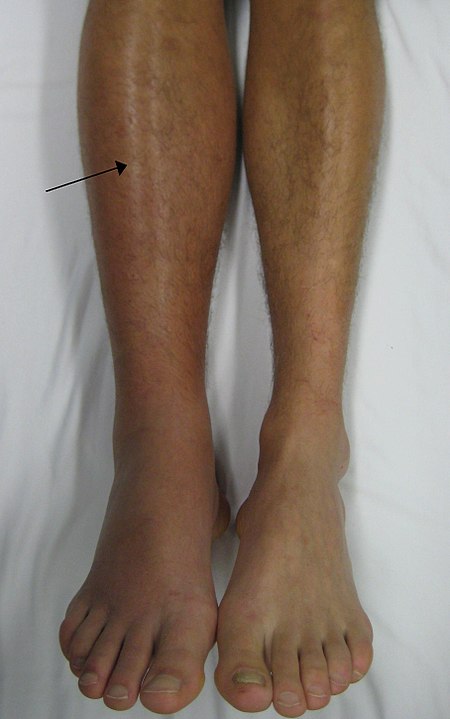Safety Considerations
PTAs monitor for signs and symptoms of pre-operative and post-operative complications associated with fracture and fracture repair. Any suspected signs and symptoms of medical post-operative complications are immediately reported to the supervising PT and/or medical staff (nursing/PCP).
Deep Vein Thrombosis (DVT)
DVTs are blood clots which typically present in the lower limb.
Risk for DVT increases with recent history of cancer, paresis, immobilization/bed rest more than 3 days
Signs and symptoms of DVT include: limb redness, warmth, and swelling (increased limb girth), increased tenderness to touch, increased pain.
DVTs can mobilize (emboli) and result in a life-threatening pulmonary embolus. You can peruse more information in the APTA Rehab Referennce Center on "Deep Vein Thrombosis and Exercise", which is available as an optional resource in Moodle.
Exercise and soft tissue mobilization to the affected limb is contraindicated for individuals who are not receiving anticoagulant therapy until medically cleared.

Lower extremity image of DVT https://en.wikipedia.org/wiki/Deep_vein_thrombosis
Compartment Syndrome
The pressure to tissues and nerves from the internal bleeding post-fracture can develop into a medical emergency. Signs of compartment syndrome include:
- swollen, tight, shiny and tender limb
- severe pain with any passive stretch to affected area
- sensory changes (burning, numbness, tingling)
- motor weakness or paralysis
- weak or absent peripheral pulses in affected region
Pulmonary Complications
Immobilization and CNS suppressive drugs (anesthesia, pain medications, etc), can decrease the efficiency of breathing and airway clearance. Secondary complications of hospitalization due to fracture includes pneumonia and atelectasis (lung tissue collapse).
Hardware and Soft Tissue Failure
Premature weight bearing, excessive forces through healing soft tissue, and inappropriate use of orthoses can result in fracture of fixation devices and disruption of internal sutures and surgical anchors. Any sudden increases in pain or losses of function, or inability to progress to WB activities due to pain should be referred back to the supervising PT for further assessment. The result can be malunion or delayed/non-union.
Infection
Disruption of skin and bone tissue may result in local or systemic infection. Cardinal signs of inflammation, fever, shortness of breath (SOB), decreased cognition (change in arousal, A&O status) must be communicated to medical staff prior to engaging in physical activity. Vital sign monitoring before and during active-assisted and active exercises assure patient safety during activities which increase physiological stress to the cardiovascular and pulmonary systems.
Patient Education
Steps PTAs can take to empower the patient/family member to minimize risk for post-operative complications include:
- educate on importance of keeping surgical area clean: instruct in hand washing, application of gloves, avoiding direct contact with fresh incision, and monitoring for increased redness and swelling
- educate on tissue healing time and risk for reinjury/hardware failure with excessive WB, overactivity, overstretching, or resistance-based exercises
- educate on activity modification for energy conservation and joint protection during all phases of rehabilitation